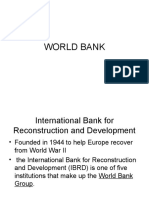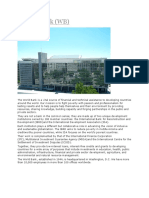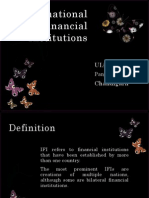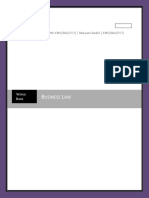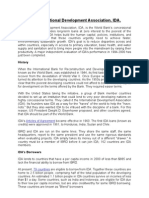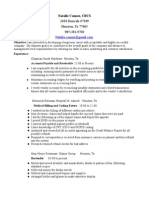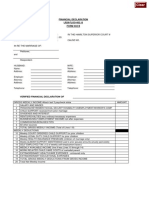Ida
Ida
Uploaded by
arun_choudhary_9Copyright:
Available Formats
Ida
Ida
Uploaded by
arun_choudhary_9Original Title
Copyright
Available Formats
Share this document
Did you find this document useful?
Is this content inappropriate?
Copyright:
Available Formats
Ida
Ida
Uploaded by
arun_choudhary_9Copyright:
Available Formats
IDA
International Development Association
Submitted by Arun Choudhary 11.MBA-10
Submitted to Prof. Amisha Gupta
Introduction
The International Development Association (IDA) is the part
of the World Bank that helps the worlds poorest countries.
Established in 1960, IDA aims to reduce poverty by providing interest-free credits and grants for programs that boost economic growth, reduce inequalities and improve peoples living conditions.
IDA complements the World Banks other lending arm.
International Bank for Reconstruction and Development
(IBRD)which serves middle-income countries with capital investment and advisory services.
IDA is one of the largest sources of assistance for the worlds 79 poorest countries,39 of which are in Africa.
It is the single largest source of donor funds for basic social
services in the poorest countries.
IDA lends money (known as credits) on concessional terms.
Membership
Members of the IDA are 170 of the UN members and Kosovo.
Non-members are: Andorra, Antigua and Barbuda, Bahrain, Belarus, Brunei, Bulgaria, Cuba, Jamaica, Liechtenstein, Malta, Monaco, Namibia, Nauru, Niue, North Korea, Qatar, Romania, San Marino, Seychelles, Suriname, Turkmenistan, Ugand a, Uruguay, Vatican City and Venezuela. The remaining non-members are states with limited recognition.
International Development Association member states
Funding
In addition to the funds received by the International Bank for Reconstruction and Development for the IDA's efforts of global aid, its more developed and economically sound member countries provide a substantial amount monetary resources. Approximately half of the IDA's resources come from the 45 donating countries. In its early years of establishment, the IDA received most of its replenishments from the United Kingdom and United States, but because they were not always reliable sources of funding during that time, other developed nations began to step in to fill the economic gaps not met by these two countries.
Contd..
Today, every three years, member nations that provide monetary funds to the IDA gather together to replenish the IDA's resources. These funds primarily come from well developed countries including the United States, Japan, France, Germany, and the United Kingdom; with 58% from the US, 22% from France, and 8% from the UK. Although the IDA's funds are now regularly replenished, this does not happen without some financial and political challenges for the donating countries
History
IBRD established in 1944 to help Europe recover -devastation of World War II
Success of that enterprise led the Bank, within a few years, to turn
its attention to developing countries
By the 1950s- poorest developing countries needed softer terms than those offered by the Bank-afford to borrow the capital they needed to grow. United States -initiative, a group of the Banks member countries decided to set up an agency that could lend to the poorest countries on the most favorable terms possible.
They called the agency the "International Development Association
Wanted IDA to be run with the discipline of a bank. (world bank) IDA's Articles of Agreement became effective in 1960. The first IDA loans, known as credits, were approved in 1961 to Chile, Honduras, India and Sudan.
IDA currently has 170 member countries
Members subscribe to IDAs -submitting necessary documentation make required payments under the replenishment arrangements.
35 countries have graduated from IDA throughout its history and some reentered
Eligibility for IDA support depends first and foremost on a countrys relative poverty, defined as GNI per capita below an established threshold and updated annually. (in fiscal year 2011: US$1,165)
IDA also supports some countries, including several small island economies, which are above the operational cutoff but lack the creditworthiness needed to borrow from IBRD.
Seventy-nine countries are currently eligible to receive IDA resources.
Top Ten IDA Borrowers
($million, includes regional projects)
India Vietnam Tanzania Ethiopia Nigeria Bangladesh Kenya Uganda Dem. Rep. Congo 2,578 1,429 943 890 890 828 614 480 460
New IDA Lending by Region:
Sub-Saharan Africa
49 %
South Asia
East Asia/Pacific Europe/Central Asia Latin America/Caribbean Middle East/North Africa
32 %
11 % 4% 2% 1%
IDA Lending by Sector:
Infrastructure Social sector 37 % 29 %
Industry
Public Admin and Law Agriculture Finance
2%
18 % 8% 5%
IDA lending's
IDA credits- maturities of 20, 35 or 40 years 10-year grace period
IDA funds are allocated to the borrowing countries relation income levels and record of success in managing their economies and ongoing IDA projects.
IDA credits have no interest charge but small service charge,
currently 0.75 percent on funds paid out.
IDA also provides grants, which are allocated to the countries that are at risk of debt distress.
In fiscal year 2010 IDA commitments totaled US$14.5 billion18% was provided on grant terms.
Since 1960, IDA has provided US$222 billion to 108 countries.
Annual commitments increased steadily and averaged about
US$13 billion over last 3 years.
IDA-financed operations address primary needs These projects pave the way toward economic growth, job creation, higher incomes and better living conditions.
IDA emphasizes broad-based growth, including:
Sound economic policies, rural development, private business and sustainable environmental practices Investment in people, in education and health, especially in the struggle against HIV/AIDS, malaria and TB Expansion of borrower capacity to provide basic services Recovery from civil trouble, armed conflict and natural disaster Promotion of trade and regional integration
IDA advises governments -broaden the base of economic growth and protect the poor from economic shocks.
IDA coordinates donor assistance to provide relief for poor countries that cannot manage their debt-service burden.
IDA developed a system for allocating grants based on countries risk of debt distress, designed to help countries ensure debt sustainability.
IBRD raises its funds on the world's financial markets, IDA is funded
largely by contributions from the governments of richer member countries.
Additional funds from IBRD's income and from borrowers' repayments
of earlier IDA credits.
Function of World Bank Groups organizations
The functions of the International Bank for Reconstruction and Development are: The assistance and development of territories of its members The promotion of a balanced growth in international trade The International Development Association seeks to: Promote world development, increase productivity and standards of leaving in the less developed countries of its membership Assist the International Bank for Reconstruction and Development
Introduction
Official Development Assistance (ODA) flows are a primary source of financing for low- income countries (LICs), and IDA continues to be their main source of multilateral ODA IDAs role in the international aid architecture - financing and knowledge service and support aid delivery platform In light of the growing complexity of the global aid architecture, IDAs role in supporting LICs has become even more important.
The country-based development model in a changing aid landscape
There is broad agreement that the country-based development model
However, some recent trends in ODA flows are potentially at odds
IDAs role at the country level
Client surveys indicate that IDAs core strengths reside in its financial resources - but also, in its global reach combined with local presence, its ability to operate on a multi-sectoral basis These core strengths enable IDA not only to provide direct support to client countries IDA brings greater strategic coherence in development assistance programs and plays a central role in enhancing alignment and harmonization as well as in achieving sustained results at the country level.
Challenges going forward and conclusion
Focuses on the main challenges going forward and how IDA is gearing up to address them.
IDA will have to adapt and intensify its efforts in four main areas: (i) strengthening complementarity with vertical approaches to aid delivery; (ii) ensuring appropriate sectoral funding; (iii) addressing critical global challenges with an increased priority given to climate change; (iv) and enhancing alignment and harmonization.
IDA is also in the process of reforming and modernizing its operational policies, designed to improve its operational effectiveness and thus its ability to meet the challenges outlined above.
THANK YOU
You might also like
- Account Summary Payment Information: New Balance - $78.87Document6 pagesAccount Summary Payment Information: New Balance - $78.87AriadnaUrsachi100% (1)
- Assessment of Microinsurance as Emerging Microfinance Service for the Poor: The Case of the PhilippinesFrom EverandAssessment of Microinsurance as Emerging Microfinance Service for the Poor: The Case of the PhilippinesNo ratings yet
- Mutual Funds in India: Structure, Performance and UndercurrentsFrom EverandMutual Funds in India: Structure, Performance and UndercurrentsNo ratings yet
- 10.world BankDocument19 pages10.world BankAdnan NawabNo ratings yet
- IdaDocument21 pagesIdaIla Gupta0% (1)
- AnkitDocument24 pagesAnkitAnkit MalhotraNo ratings yet
- IBF Assignment: World Bank: Professor: Mr. KannanDocument6 pagesIBF Assignment: World Bank: Professor: Mr. KannanHarish MuralidharNo ratings yet
- EconomicsDocument7 pagesEconomicskcsujan8No ratings yet
- IDADocument13 pagesIDASumi Dharmaraj100% (4)
- Agencies PDFDocument9 pagesAgencies PDFFurqan AhmedNo ratings yet
- Module 3 PDFDocument21 pagesModule 3 PDFRAJASAHEB DUTTANo ratings yet
- International Bank For Reconstruction and Development (Ibrd)Document4 pagesInternational Bank For Reconstruction and Development (Ibrd)Sai SuryaNo ratings yet
- World Bank AssignmentDocument16 pagesWorld Bank AssignmentAarzoo Dalal67% (3)
- If Is ButterflyDocument29 pagesIf Is Butterflyicha95bestNo ratings yet
- International Economic InstitutionsDocument33 pagesInternational Economic InstitutionsRavinder YadavNo ratings yet
- Poorest Fund: For TheDocument23 pagesPoorest Fund: For Theares_aguilarNo ratings yet
- World Bank: Presented By: Jatin VaidDocument14 pagesWorld Bank: Presented By: Jatin VaidEsha100% (1)
- Ifc & IdaDocument12 pagesIfc & Idanavneet_sahota05100% (4)
- ESCALONA MAY E - ASSIGNMENT - World Bank, IMF, and ADBDocument4 pagesESCALONA MAY E - ASSIGNMENT - World Bank, IMF, and ADBMa YaNo ratings yet
- World BankDocument11 pagesWorld BankAnjanette SantosNo ratings yet
- 12-International Institutions and Role in International BusinessDocument13 pages12-International Institutions and Role in International Businessfrediz7971% (7)
- World Bank, ADB, BRICSDocument23 pagesWorld Bank, ADB, BRICSRohith RavikumarNo ratings yet
- Presented by Muhammad Abdullah Waqas Hussain Saqib-ur-Rehman Muhammad Rizwan YounasDocument23 pagesPresented by Muhammad Abdullah Waqas Hussain Saqib-ur-Rehman Muhammad Rizwan Younasch_rizwanyounasNo ratings yet
- Lecture 10.odtDocument3 pagesLecture 10.odtRaza AliNo ratings yet
- The World Bank ProjectDocument62 pagesThe World Bank ProjectVishal KainthlaNo ratings yet
- International Financial InstitutionsDocument29 pagesInternational Financial InstitutionsPaavni SharmaNo ratings yet
- World BankDocument34 pagesWorld Bankdivyesh_variaNo ratings yet
- Presentation On World Bank: Giridhar KattiDocument22 pagesPresentation On World Bank: Giridhar KattindtNo ratings yet
- Rishi Dubey (IBE)Document19 pagesRishi Dubey (IBE)Rishi DubeyNo ratings yet
- Usiness AW: Khaula Basalat (1989-FMS/BBA/FO7) - Maryam Bashir (-FMS/BBA/FO7)Document10 pagesUsiness AW: Khaula Basalat (1989-FMS/BBA/FO7) - Maryam Bashir (-FMS/BBA/FO7)kbasalat100% (1)
- World Bank Enhances Lending CapacityDocument5 pagesWorld Bank Enhances Lending CapacityŠʉʟʇḁɲ ŜħēiḱḩNo ratings yet
- World Bank ReportDocument14 pagesWorld Bank Reportaditya_erankiNo ratings yet
- The World BankDocument9 pagesThe World Banksakali aliNo ratings yet
- About International OrganisationsDocument6 pagesAbout International Organisationscmeps81No ratings yet
- Organization: So That Is The Difference But Not That Much Right?Document8 pagesOrganization: So That Is The Difference But Not That Much Right?Stella BertilloNo ratings yet
- International Bank For Reconstruction and Development (IBRD) International Development Association (IDA)Document12 pagesInternational Bank For Reconstruction and Development (IBRD) International Development Association (IDA)9986212378No ratings yet
- Project On International BusinessDocument13 pagesProject On International BusinessShreya JainNo ratings yet
- World Ban1finalDocument12 pagesWorld Ban1finalhiteshbohra08No ratings yet
- Kaushal ChandakDocument24 pagesKaushal ChandakAmit R SinghaniaNo ratings yet
- World BankDocument29 pagesWorld BankJijoraj R SNo ratings yet
- Presentation On World Bank: Giridhar KattiDocument22 pagesPresentation On World Bank: Giridhar KattiAryanNo ratings yet
- World Bank GroupDocument8 pagesWorld Bank GroupSuvankar NandiNo ratings yet
- What Is The World BankDocument4 pagesWhat Is The World BankPrincess KanchanNo ratings yet
- The International Development Association, IDA,: HistoryDocument7 pagesThe International Development Association, IDA,: Historymanojpatel51No ratings yet
- World Bank: BY-Binit Chouraria Navneet Mayank Nishant DaveDocument30 pagesWorld Bank: BY-Binit Chouraria Navneet Mayank Nishant DaveNavneet MayankNo ratings yet
- World Bank GroupDocument8 pagesWorld Bank GroupkarthickNo ratings yet
- Ifm LessonDocument27 pagesIfm LessonAicha EssNo ratings yet
- World Bank: Neha Bhartiya (130) Prateek Meharia (138) Punit RajmohanDocument30 pagesWorld Bank: Neha Bhartiya (130) Prateek Meharia (138) Punit RajmohanPrateek MehariaNo ratings yet
- International Financial Institutions / Development Banks: by Prof Sameer LakhaniDocument38 pagesInternational Financial Institutions / Development Banks: by Prof Sameer Lakhanimanmeetginni123No ratings yet
- World Bank PresentationDocument22 pagesWorld Bank PresentationFaheem RahmanNo ratings yet
- World Bank FunctionDocument6 pagesWorld Bank FunctionLem0nz1 Lem0nz1No ratings yet
- Forex Assignment 1Document6 pagesForex Assignment 1Aditi BindalNo ratings yet
- UntitledDocument67 pagesUntitledAshish RickyNo ratings yet
- World Bank and WTODocument12 pagesWorld Bank and WTOmahinderNo ratings yet
- IBRDDocument5 pagesIBRDMohsin G100% (1)
- World BankDocument13 pagesWorld BankFahd GhumanNo ratings yet
- World Bank PPT at Bec Doms Bagalkot MbaDocument50 pagesWorld Bank PPT at Bec Doms Bagalkot MbaBabasab Patil (Karrisatte)No ratings yet
- World Bank MacroDocument4 pagesWorld Bank MacroHamza KhalidNo ratings yet
- World Bank World Bank: World Bank Logo International Organization Treaty Crediting 186 CountriesDocument74 pagesWorld Bank World Bank: World Bank Logo International Organization Treaty Crediting 186 CountriesBharat ShahaneNo ratings yet
- Role of World BankDocument12 pagesRole of World BankKamrulIslam100% (1)
- Notes On RBI POLICIES & GUIDELINES 2019 - DarpanDocument49 pagesNotes On RBI POLICIES & GUIDELINES 2019 - DarpannitinspaulNo ratings yet
- Housing in The PhilippinesDocument5 pagesHousing in The PhilippinesJennina Santi Codog ValduezaNo ratings yet
- Framework For Employee-Incentive PlanDocument21 pagesFramework For Employee-Incentive PlanRezaNo ratings yet
- Associated Insurance Vs IyaDocument1 pageAssociated Insurance Vs IyaAngelee Therese AlayonNo ratings yet
- Law On Sales: Atty. Lilibeth Davis Gabutero, CPA, MBADocument193 pagesLaw On Sales: Atty. Lilibeth Davis Gabutero, CPA, MBAJerry PinongpongNo ratings yet
- Financial Management Ch06Document52 pagesFinancial Management Ch06Muhammad Afnan MuammarNo ratings yet
- Financial Distress (2008)Document24 pagesFinancial Distress (2008)Ira Putri100% (2)
- Moot ProblemDocument12 pagesMoot ProblemAchin JanaNo ratings yet
- Nfjpia Nmbe Afar 2017 AnsDocument10 pagesNfjpia Nmbe Afar 2017 AnshyosungloverNo ratings yet
- Challenges Posed by Globalisation in Operations Management of A Global CompanyDocument5 pagesChallenges Posed by Globalisation in Operations Management of A Global CompanyrobinsonsgNo ratings yet
- Ajay Summer Project Report at AU FINANCIERS PDFDocument71 pagesAjay Summer Project Report at AU FINANCIERS PDFLekha BorleNo ratings yet
- OO0519Document16 pagesOO0519Anonymous 9eadjPSJNgNo ratings yet
- HSBC Vs ALdecoaDocument14 pagesHSBC Vs ALdecoaJohn Felix Morelos DoldolNo ratings yet
- Peer To Peer Lending Platform: Submitted by Lohith Om Prakash Shinjan VamshiDocument6 pagesPeer To Peer Lending Platform: Submitted by Lohith Om Prakash Shinjan VamshiLohith KumarNo ratings yet
- Factoring As An Important Tool For Working Capital ManagementDocument25 pagesFactoring As An Important Tool For Working Capital ManagementRupal HatkarNo ratings yet
- 66 Restructure DebtsDocument30 pages66 Restructure DebtsVikas JainNo ratings yet
- COMPILATION BAR QUESTIONS WEEKS 16, 17, & 18 - EXECUTIVE CLASS FINAL For PrintDocument123 pagesCOMPILATION BAR QUESTIONS WEEKS 16, 17, & 18 - EXECUTIVE CLASS FINAL For PrintEdeline Cosicol0% (1)
- Eoif Working Capital FinanceDocument16 pagesEoif Working Capital Financeengr_asad364No ratings yet
- Sales Doctrines (SIENNA FLORES)Document15 pagesSales Doctrines (SIENNA FLORES)Nori LolaNo ratings yet
- PropertyDocument84 pagesPropertyNeo KigzNo ratings yet
- National Investment and Development Corp. vs. AquinoDocument25 pagesNational Investment and Development Corp. vs. AquinoXtine CampuPotNo ratings yet
- ReceivablesDocument4 pagesReceivableshellohello50% (2)
- Servicewide Specialists Inc. v. CA (November 1999)Document2 pagesServicewide Specialists Inc. v. CA (November 1999)Ian VillafuerteNo ratings yet
- 3030 Dunvale #7109 Houston, TX 77063 985-381-9760: Natalie Conner, CBCSDocument2 pages3030 Dunvale #7109 Houston, TX 77063 985-381-9760: Natalie Conner, CBCSnatconnerNo ratings yet
- Documentation Full Doc: Amlak Fixed Amlak ProductDocument3 pagesDocumentation Full Doc: Amlak Fixed Amlak ProductnajeeebinNo ratings yet
- Financial Declaration LR29-FLOO-402.10 Form 402 BDocument4 pagesFinancial Declaration LR29-FLOO-402.10 Form 402 BwgearharNo ratings yet
- Norma I. Baring, Petitioner, V. Elena Loan and Credit Company, IncDocument5 pagesNorma I. Baring, Petitioner, V. Elena Loan and Credit Company, IncAnonymous admm2tlYNo ratings yet
- 52 Essential Real Estate Terms You Should Know - OpendoorDocument23 pages52 Essential Real Estate Terms You Should Know - OpendoorAtul SharmaNo ratings yet
- Non-Disturbance AgreementDocument2 pagesNon-Disturbance AgreementRocketLawyerNo ratings yet




